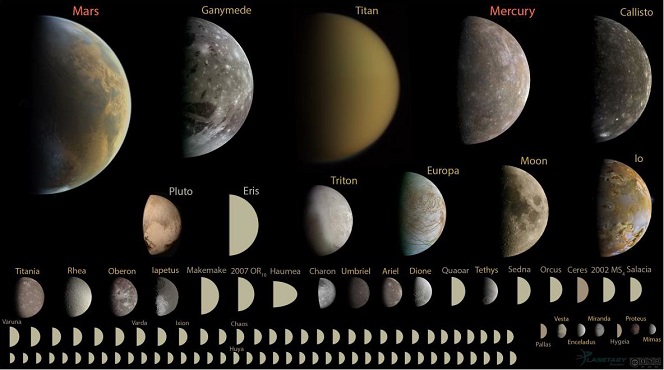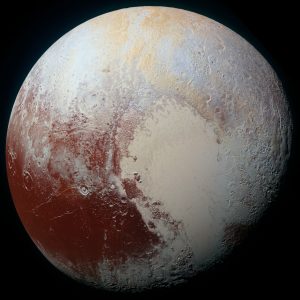Definition: Asteroid, Meteorite, Meteor, Meteoroid, (Dwarf) Planet & Other Terms
Asteroid

A 1 m to ~530 km natural irregularly-shaped solid object moving in interplanetary space. The lower limit is defined by NASA as 10 m. However, based on the 1 m upper limit of a “meteoroid” proposed by Alan Rubin and Jeffrey Grossman above, and the need for a consistent taxonomy for these different objects, the lower limit of 1 m is used here. The upper limit was originally based on the largest asteroid in our solar system, Ceres, with a mean diameter of 939.4±0.2 km. However, Ceres is now considered a dwarf planet because it is now known to be massive enough that its gravity pulls itself into a nearly round shape. With the reclassification of Ceres as a dwarf planet, the upper limit of an asteroid is now set to ~530 km, based on the diameter of the asteroid 4-Vesta. Note that the IAU never officially defined the term “asteroid” as it falls under their definition of “Small Solar System Bodies”. These Small Solar System Bodies are not planets, dwarf planets or satellites like moons, but do orbit the sun and currently include most of the Solar System asteroids, most Trans-Neptunian Objects (TNOs), comets, and other small bodies like meteoroids. Asteroids are sometimes referred to as Minor Planets.
Meteorite

A natural solid object larger than 10 μm in size that was ejected by the impacts between meteoroids and/or larger natural bodies, was then transported by natural means from the body from which it was ejected to a region outside the dominant gravitational influence of that body, and later, when their orbits intersected, collided with a natural or artificial body larger than itself (even if it is the same body from which it was launched). Meteorites found on Earth, or any planet with a sufficiently dense gaseous atmosphere, will also experience ablation due to frictional forces experienced during the object’s high velocity entry through the planet’s atmosphere. An object loses its status as a meteorite if it is incorporated into a larger rock that becomes a meteorite itself.
Weathering processes do not affect an object’s status as a meteorite as long as something recognizable remains of its original minerals or structure. These highly altered materials that have a meteoritic origin but are dominantly (>95%) composed of secondary minerals formed on the body on which the object was found are called Relict Meteorites. (Meteoritical Society, 2006)
Meteor
Asteroids and meteoroids are both considered meteors when they enter Earth’s atmosphere. The term
- The fastest velocity will occur when the Earth and the
meteor are moving towards each other on a direct collision course. So, the fastest theoretical entry velocity is 42 km/s + 30 km/s, an astounding 72 km/s (259,0000 km/h or 161,000 mph)! - The slowest velocity will occur when the
meteor is moving in from behind the Earth. So, the slowest theoretical entry velocity is 42 km/s – 30 km/s, a still impressive 12 km/s (43,000 km/h or 27,000 mph)!
A very large meteor is known as a fireball and is usually caused by a larger body. A meteoroid or asteroid the size of a boulder or car will produce a very large and bright fireball even in the daylight. (NOTE: The International Astronomical Union defines a fireball as “a meteor brighter than any of the planets” (magnitude -4 or greater)
The massive Chelyabinsk fireball from Feb. 15, 2013 over Chelyabinskaya oblast’, Russia
Meteoroid
A 10 μm to 1 m sized natural solid object moving in interplanetary space. Meteoroids might be primary objects, or derived by the fragmentation of larger celestial bodies, including but not limited to asteroids.
Planet

The term “planet” originally comes from the Greek word for “wanderer” since these objects were seen to move in the sky independently from the background of fixed stars that moved together through the seasons. The IAUThe International Astronomical Union (IAU) was founded in 1919. Its mission is to promote and safeguard the science of astronomy in all its aspects, including research, communication, education and development, through international cooperation. The IAU also works to promote research, education and public outreach activities in astronomy for the public. Click on Term to Read More last defined the term planetThe term "planet" originally comes from the Greek word for "wanderer" since these objects were seen to move in the sky independently from the background of fixed stars that moved together through the seasons. The IAU last defined the term planet in 2006, however the new definition has remained controversial. Click on Term to Read More in 2006, however the new definition has remained controversial. The IAU’s definition applies only to our Solar SystemThe Sun and set of objects orbiting around it including planets and their moons and rings, asteroids, comets, and meteoroids. and so the definition below has been edited for clarity and generalized to apply to extrasolar planets (exoplanets) as well.
- A celestial body that orbits a starSelf-luminous object held together by its own self-gravity. Often refers to those objects which generate energy from nuclear reactions occurring at their cores, but may also be applied to stellar remnants such as neutron stars. or stellar remnant.
- Has sufficient mass for its self-gravity to overcome rigid body forces so that it assumes a hydrostatic equilibriumBalance between gravity and gas pressure. In the case of a star, gravity originates in mutual gravitational attraction of the entire mass of the star. Gas pressure is produced by nuclear reactions that heat the star's gas. Any change in the internal temperature of a star results in a change Click on Term to Read More (nearly round) shape, but not massive enough to become a star.
- Has cleared the gravitational neighborhood around its orbitThe elliptical path of one body around another, typically the path of a small body around a much larger body. However, depending on the mass distribution of the objects, they may rotate around an empty spot in space • The Moon orbits around the Earth. • The Earth orbits around Click on Term to Read More.
For an object to assume a round or nearly round shape, the object should generally have a mass above 5 x 1020 kg and diameter greater than 800 km. However, borderline cases would have to be established by observation.
The original draft of the 2006 IAU resolution redefined hydrostatic equilibriumTerm used to describe physical or chemical stasis. Physical equilibrium may be divided into two types: static and dynamic. Static equilibrium occurs when the components of forces and torques acting in one direction are balanced by components of forces and torques acting in the opposite direction. A system in static Click on Term to Read More shape as applying “to objects with mass above 5 × 1020 kg and diameter greater than 800 km”, but this was not retained in the final draft since the composition and mass of an object determine the minimum diameter to achieve a rounded shape. Even though bodies made of denser materials become spherical at smaller radii, an objects composition and associated compressibility tend to drive the minimum diameter. Therefore, for bodies made mainly of rock, the minimum diameter to assume a round or nearly round shape is about 600 km diameter. For bodies made mainly of ice, the minimum diameter drops to about 400 km diameter1.
The IAU accepted planets of our Solar SystemDefinable part of the universe that can be open, closed, or isolated. An open system exchanges both matter and energy with its surroundings. A closed system can only exchange energy with its surroundings; it has walls through which heat can pass. An isolated system cannot exchange energy or matter with closest to farthest from the SunOur parent star. The structure of Sun's interior is the result of the hydrostatic equilibrium between gravity and the pressure of the gas. The interior consists of three shells: the core, radiative region, and convective region. Image source: http://eclipse99.nasa.gov/pages/SunActiv.html. The core is the hot, dense central region in which the are Mercury, Venus, Earth, Mars, Jupiter, Saturn, Uranus and Neptune. A stellar memory device (mnemonic) can be seen on the page Remember the Planets!.
The Case For and Against Pluto
Since, according to the IAU’s new definition, Pluto has not cleared its orbital space and shares it with many other objects in the Kuiper BeltRegion in the outer solar system beyond Neptune's orbit that contains billions of small, icy planetesimals from the original protoplanetary disc that failed to coalesce into planets. The Kuiper Belt extends from Neptune's orbit at 30 AU to ~55 AU. It is ~20x wider and 20-200x more massive than the Click on Term to Read More, it was reclassified as a dwarf planet. However, not all scientists agree. Dr. Alan Stern argues that the requirement for clearing the neighborhood or zone is “sloppy” based on the following reasons summarized from his interview Fighting for Pluto’s Planet Title and from this author’s additional research:
- No planets in our Solar System orbit in a fully cleared zone. All have some form of asteroids, comets or Kuiper Belt objectsGenerally, small bodies found in the Kuiper Belt. The largest Kuiper Belt Object (KBO), Eris, is <3000 km in diameter. Image source: http://en.wikipedia.org/wiki/File:EightTNOs.png Click on Term to Read More passing through their orbital zone. These objects typically have orbits that intersect Pluto’s orbit, but do not necessarily share its same orbit. However, even if we assume a stricter definition of clearing the neighborhood of objects that share the same orbit, even this requirement cannot be met by other planets in our Solar System. For example, the Trojan asteroids are comprised of two large groups of asteroids that orbit ahead and behind Jupiter in the same orbit around the Sun as Jupiter.
- At increasingly farther distances from the sun, an object’s orbit increases and it’s orbital speed decreases, therefore zone clearing takes longer and is more difficult. This situation imposes a distance dependence where identical objects don’t classify identically at different distances from the Sun. As Alan Stern puts it, “when people say Pluto can’t clear its orbital zone, they should be fair and also point out that planet Earth also couldn’t clear a zone this far out, so the IAU definition would exclude an Earth – and a Mercury,a Venus or a Mars – at Pluto’s distance.”
Geophysical Definition of a Planet
This continued controversy led to the following geophysical definition for planet being proposed by Runyon et al., #1448 (2017), and emphasizes a body’s intrinsic physical properties over its extrinsic orbital properties. This definition currently describes ~110 known planets in the solar system.

“A planet is a sub-stellar mass body that has never undergone nuclear fusionProcess in which two lighter atomic nuclei combine to form a heavier atomic nucleus. Very high temperatures are normally required in order for atomic nuclei to collide with sufficient energy to overcome the Coulomb barrier (their mutual electrostatic repulsions). Fusion that occurs under high-temperature conditions is called thermonuclear fusion. Fusion Click on Term to Read More and that has sufficient self-gravitation to assume a spheroidal shape adequately described by a triaxial ellipsoid regardless of its orbital parameters.”
Dwarf Planet

A celestial body that orbits around a sun, has sufficient mass for its self-gravity to overcome rigid body forces so that it assumes a hydrostatic equilibrium (nearly round) shape, has not cleared the neighborhood around its orbit, and is not a satellite like a moon. Ceres, Pluto, Eris, Makemake and Haumea are the only 5 objects in our solar system accepted by the IAU to be examples of “dwarf planets”.
Interplanetary Dust Particle (IDP)

A particle smaller than 10 μm in size moving in interplanetary space. If such particles subsequently accrete to larger natural or artificial bodies, they are still called IDPs.
Earth accumulates an estimated 30,000 t of space dust each year. If Earth or other planets don’t intersect their path, they will eventually be destroyed when they fall into the Sun. They have a relatively short lifespan of one to hundred thousand years implying that this dust is formed on a continuous basis and did not originate from our solar system’s formation. There is strong evidence that ~80% of IDPs are of cometary origin.
Micrometeorite

A subset of meteorites, a micrometeorite is a meteorite between 10 μm and 2 mm in size. Micrometeorites are often heavily melted.
Citizen Scientist (musician and overall very cool guy), John Larsen, initiated this new field of science and wrote a great book on the subject called In Search of Stardust: Amazing Micrometeorites and Their Terrestrial Imposters. John has encouraged people to go out and to find their own micrometeorites using just a few simple tools and a technique he outlines on his Project Stardust Facebook page and in his other book On the Trail of Stardust: The Guide to Finding Micrometeorites: Tools, Techniques, and Identification. To learn more about how John began his journey, you can read an excellent article here. Yes, you too may find a micrometeorite on your roof!
Micrometeoroid
A meteoroid between 10 μm and 2 mm in size.
Meteor Shower

Remnants of dust and micrometeoroids left over by the passage of comets through our solar system that intersect Earth’s orbit throughout the year. These intersections produces what we know as meteor showers like the Leonids, Geminids, and Quadrantids, and each has their own regular yearly schedule. The meteor showers get their names from the radiant where they seem to originate in the sky. For example the Leonids radiant is the constellation of Leo. Occasionally, a meteor shower may be caused by the fragmentation of an asteroid. See the chart of when meteor showers occur each year.
The International Astronomical Union (IAU) voted on August 24, 2006 to adopt a new definition for the terms planet and dwarf planet based on resolution B5. Definitions for asteroid, meteor and meteor shower are adapted from various sources as listed. Some definitions have, to some degree, been modified for clarity and/or consistency.






